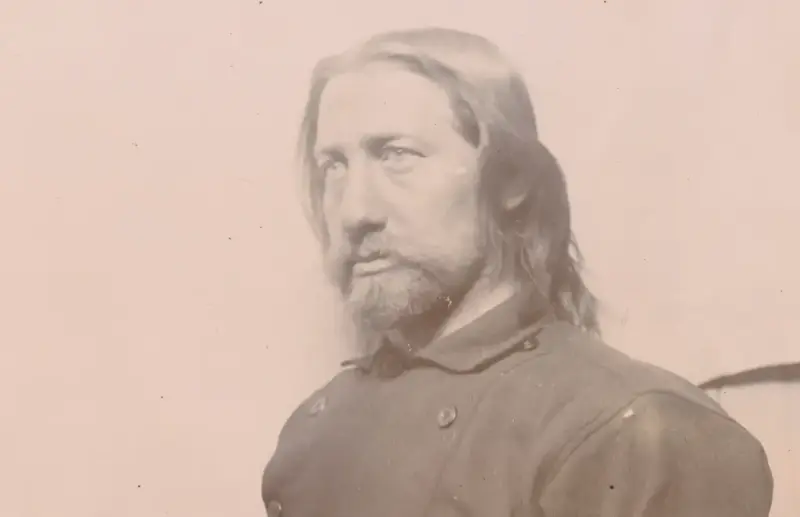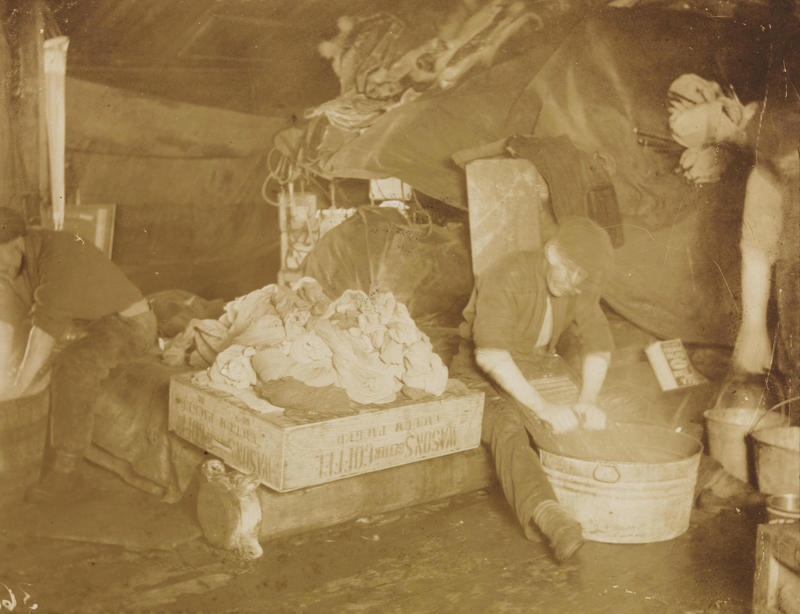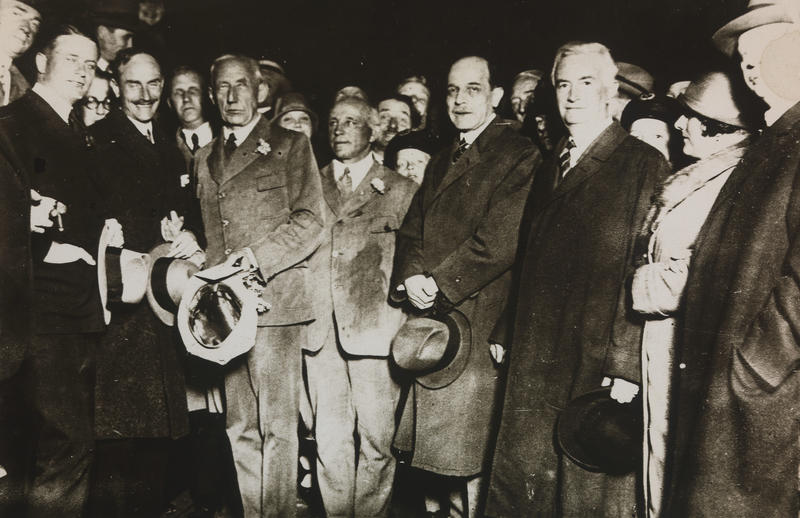Timeline: The life of Roald Amundsen
1872
Roald Engebreth Gravning Amundsen is born 16 July. After a couple of months, the family moves from “Tomta” in Borge (Østfold) to Christiania (Oslo). Roald Amundsen grows up together with his older brothers Leon, Gustav and Tonni in Uranienborgveien 9.

Capt. Jens Amundsen with his four sons. Roald is leaning on his father’s lap. Private collection
1886–1889
His father, the shipowner Jens Amundsen, dies when Roald is 14 years old. At home, the nanny Betty takes over primary care of the boys. The following year, Roald reads the books by polar explorer Sir John Franklin with glowing interest. In 1889, at the age of 17, Roald witnesses Fridtjof Nansen’s return from the Greenland expedition in downtown Oslo.
... for the first time something in my secret thoughts whispered clearly and tremulously: If you could make the North West Passage!

Roald Amundsen in his teens. Private collection
1890–1893
In autumn 1890, Roald begins university and gradually throws himself into medical studies.
In autumn 1893, his mother, Gustava (born Sahlqvist), dies and Roald ends his studies. He serves his compulsory military duty in the Kristiania (Oslo) Battalion at Gardermoen.

Gustava Amundsen was the daughter of the baliff Gustav Sahlqvist. Follo Museum/MiA
1893–1896
In December 1893, Amundsen sets off on an unsuccsessful ski tour over the Hardangervidda with Laurentius Urdahl and Wilhelm Holst.
In spring 1894, Roald finds employment on the seal ship the Magdalena.
In January 1896, Roald sets off on another ski tour over the Hardangervidda. This time with his brother, Leon.
In summer 1896, Amundsen applies for a place on the Belgian Antarctic Expedition led by Adrien de Gerlache. He is first taken on as a sailor and a skier, but during the expedition, he becomes First Mate.

Urdahl, Holst and Amundsen posing with mountain equipement for the photographer. Amundsen to the right. The Ski Museum
1897–1899
In winter 1897, Roald is in Antwerp to learn navigation as a part of his preparations for the Antarctic. However, he interrupts his stay when he finds his landlady dead; she has taken her own life. The two had a close relationship, and Amundsen takes it badly.
The Belgica expedition departs Antwerp on 16 August 1897. In March 1898, they are frozen fast in the ice and must overwinter. The expedition gives Amundsen invaluable experience and creates a close friendship with the American expedition doctor, Frederic Cook.
In March 1899, the Belgica sails out of the ice and begins the journey home.

Frederic Cook served as doctor on bord the Belgica. Amundsen and Cook had a lifelong friendship. Follo Museum/MiA
1899–1901
In September 1899, Roald and Leon cycle from Kristiania (Oslo) to Paris. From there, he travels to the USA. On the journey, he reads Fredrick Jackson’s A Thousand Days in The Arctic and fills two books with his own notes.

The scientist Georg Balthasar von Neumayer. Follo Museum/MiA
1903–1906
The Gjøa sails through the Northwest Passage. Amundsen is the leader. The crew consists of Anton Lund, Helmer Hanssen, Peder Ristvedt, Godfred Hansen, Gustav Juel Wiik and Henrik Lindstrøm.

Roald Amundsen in Nome, Alaska. Most likely taken after sailing through the Northwest Passage. National Library of Norway
1908
In May 1908, Roald purchases a part of the Rødsten property in Svartskog and calls the house “Uranienborg”. Leon and his family later move into the house next door at Rødsten.
In November, Amundsen presents plans for a North Pole Expedition to The Geographical Society in Kristiania (Oslo).

Uranienborg a short time after Amundsen purchased the house in 1908. Follo Museum/MiA
1909
The news that the North Pole has been reached is printed in Norwegian newspapers. On 21 April 1908, the American, Frederik Cook, Amundsen’s friend from the Belgica, claims to have reached the North Pole. Sometime later, Robert Peary claims that he has been there and that Cook is a liar. Both expeditions are controversial today.
Amundsen informs the crew that his North Pole Expedition is on hold. He then travels to Copenhagen to meet Cook. In secret, Amundsen begins planning an expedition to the Antarctic and South Pole.

Amundsen in the living room at Uranienborg in 1909. Photo by Anders Beer Wilse. The National Library of Norway
1910–1912
June 1910, the polar ship the Fram is anchored outside Uranienborg. Few know at this point that the expedition’s goal is no longer the North Pole, but the South Pole.
On 14 December 1911, Amundsen stands with Oscar Wisting, Sverre Hassel, Helmer Hansen and Olav Bjaaland at the South Pole. They are the first to do so in history.

The Fram on the water outside Uranienborg before departure for the Antarctic in 1910. Postcard published by Mittet & Co
1914-1918
On 11 June 1914, Amundsen obtains a pilot’s license under dramatic circumstances; he emerges unscathed from a plane crash and later completes the exam.
World War I impacts the planning of Amundsen’s expedition over the Arctic Ocean, but on 7 June 1917, the new polar vessel the Maud is launched.
In January 1918, Amundsen travels to the front lines of Western Europe. Later that spring, he holds several lectures in the USA to encourage the support of the Western powers in the war.

Program for one of the lectures Amundsen held in the USA where he spoke about his visit to the Western Front. Follo Museum/MiA
1918–1921
In summer 1918, the Maud sails from Norway towards the Northeast passage. On board are Amundsen, Oscar Wisting, Harald U. Sverdrup, Knut Sundbeck, Peter Tessem (d. 1919), Helmer Hanssen, Paul Knudsen (d. 1919), Martin Rønne, Emanuel Tønnesen and Genadij Olonkin.
In 1920, Roald takes the young polar bear, Marie, on board, but after only a month, she is killed. She was later stuffed and taken to Uranienborg.
Two Inuit girls, Camilla and Kakonita, come on board in 1921 while the Maud is in East Siberia. In May, Amundsen leaves the Maud and travels with the two girls to Nome, Alaska. They spend the rest of the year in Seattle.

Roald Amundsen washing his clothes on board the Maud. Follo Museum/MiA
1922–1925
Under the leadership of Wisting, with Sverdrup, Olonkin, Karl Hansen, Søren Syvertsen (d. 1923), Finn Malmgren, Odd Dahl and the Chukchi, Kakot on board, an attempt is made to drive the Maud through the North Pole ice.
After spending much of the year in the USA, Camilla and Kakonita travel to Norway in January 1922 with Elise Wisting. Amundsen arrives in the country some time later.
In June 1922, Amundsen meets Elisabeth “Bess” Magids aboard the Victoria from Nome to Seattle.
In September 1924, Amundsen goes bankrupt.

Kakonita and Camilla at the gate to Uranienborg, summer of 1922. Private collection
May 1925
Amundsen departs towards the North Pole with the two Dornier-Wall airboats N24 and N25 from Ny-Ålesund, Spitsbergen, accompanied by Hjalmar Riiser-Larsen Karl Feucht, Leif Dietrichson, Lincoln Ellsworth and Oskar Omdal.
They must make an emergency landing on the ice at 88° north. After 25 days on the ice, the crew manages to take off with the N25 and they return home.

Roald Amundsen before departure from Ny-Ålesund. Follo Museum/MiA
1926
On 12 April, Amundsen holds a radio talk from his home at Svartskog.
The same month, a trial is taking place between Roald and Leon about the houses at Svartskog. The trial ends in a settlement and the houses are sold to Roald’s friends Hermann Gade and Don Pedro Christophersen.
In May, the airship Norge takes off from Ny-Ålesund. On board are 16 men and the fox terrier Titina. They fly over the North Pole and land in Teller, Alaska 72 hours after departure. Amundsen and Oscar Wisting are the first two to plant a flag on both poles.
In June, Gade and Don Pedro gift the two properties in Bunnefjorden to Amundsen.

Lincoln Ellsworth and Roald Amundsen photographed in Nome after the flight with the airship. National Library of Norway
1927
This year Amundsen publishes his autobiography, My Life as an Explorer. In a letter he writes about the biography:
I have now finished my memoirs.
God damn – they are ugly!
In the summer, Amundsen goes on a lecture tour of Japan.
Before Christmas “Bess” Magids comes to stay with Amundsen at Uranienborg until March. She then returns to Alaska.

Roald Amundsen visiting Japan. National Library of Norway
1928
On 25 May, Umberto Nobile crashes in the airship Italia on the ice north of Svalbard. Amundsen wants to participate in the rescue operation.
On 16 June, he closes the door to Uranienborg for the last time and travels with the night train to Bergen. There he meets the French naval aircraft Latham 47 and the French crew.
On 18 June, they take off from Tromsø on a northward course. Little debris is found afterwards.
A few weeks later, “Bess” Magids arrives in Oslo with a transatlantic liner. She lives at Uranienborg for a short time, waiting for Amundsen to return. She becomes the house’s last occupant.

Roald Amundsen at the Oslo East Railway Station the evening of 16 June before departing for Bergen. National Library of Norway
